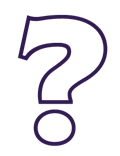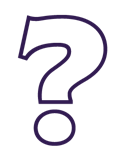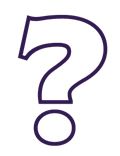4.5: The Purpose of Observation
- Page ID
- 86694
Regular and systematic observations allow us to reflect on all aspects of our job as early childhood educators. To ensure high-quality practices we should observe the program environment, the interactions between the children and teachers, and each child’s development. With the information we gather from on-going observations we can:
- Improve teaching practices
- Plan curriculum
- Assess children’s development
- Partner with families
Let’s review each concept more closely to better understand why we observe.
To Improve Teaching Practices
As we watch and listen to children throughout the day, we begin to see them for who they are. With each interaction and experience, we can see how children process information and how they socialize with their peers. We can learn so much about a child if we take the time to watch, listen, and record on a daily basis. Teachers are sometimes influenced by their own ideas of how children should behave. Truth be told, everything passes through a filter that is based on the observer’s beliefs, cultural practices, and personal experiences. As observers, we must be aware that our own biases can impact our objectivity. To gain perspective and to be most effective, we must train ourselves to slow down and step back, we must try to focus on what the child is actually doing, rather than judging how they are doing it or assuming why they are doing it. To practice becoming more objective, imagine you are a camera taking snapshots of key moments. As you observe the children in your care - practice recording just the facts. [37]
To Plan Effective Curriculum
When I was a teacher some years ago, I planned activities and set up the environment based on my interests and ideas of what I thought children should be learning. Today I realize that optimal learning occurs when curriculum reflects the children’s interests. To uncover their interests, teachers need to observe each child as an individual, in addition to observing both small and large group interactions. Let’s look at the curriculum cycle to examine best practices in how to use observation to plan effective curriculum.
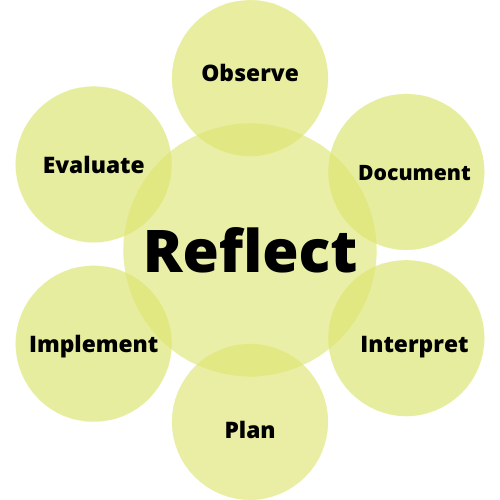
Figure \(\PageIndex{1}\): Reflection. [38]
Reflect
Reflective Practice is at the center of the curriculum planning cycle. Reflective practice helps us to consider our caregiving practices and to develop greater self-awareness so we can be more sensitive and responsive to the children we care for. As we look, listen, and record the conversations and interactions of each child, we are collecting valuable insight. With each observation, we are learning specific details about the children’s interests and abilities, their play patterns, social behaviors, problem-solving skills, and much, much more. With the information we gather, we can reflect on our caregiving practices and look at what we are doing well in addition to where we can improve. To ensure best practices, we can think about how we can become more responsive and how we can meet each child where they are in order to best support their individual needs. Reflective practice can be done alone or with co-workers - if you are team teaching. To create an inclusive learning environment that engages each child in meaningful ways, here are some prompts to help you begin reflecting on your practices:
- look at the space, materials, and daily schedule;
- Consider the cultural diversity of families;
- Think about whether or caregiving routines are meaningful;
- Think about how you are fostering relationships with families
- Consider if you are using a “one size fits all” approach
- Think about if your expectations for children match up with the age and stage of their development
- Reflect on how you are guiding children’s behavior
Let’s take a closer look at how the cycle works to help us plan and implement a developmentally appropriate curriculum.
Observe
To gather useful information about each child, we must first remember to use an objective lens. In other words, rather than assuming you know what a child is thinking or doing, it is important to learn the art of observing. To gather authentic evidence, we must learn how to look and listen with an open mind. We must learn to “see” each child for who they are rather than for who we want them to be or who we think they should be. Be assured, learning to be an objective observer is a skill that requires patience and practice. As you begin to incorporate observation into your daily routine, here are a few things to think about:
- Who should I observe? Quite simply - every child needs to be observed. Some children may stand out more than others, and you may connect to certain children more than others. In either case, be aware and be mindful to set time aside to observe each child in your care.
- When should I observe? It is highly suggested that you observe at various times throughout the day – during both morning and afternoon routines. Some key times may include during drop-off and pick-up times, during planned or teacher-directed activities, during open exploration or child-initiated activities. You may have spontaneous observations - which are special moments or interactions that unexpectedly pop up, and you may have planned observations - which are scheduled observations that are more focused around collecting evidence about a particular skill set, interaction, or behavior.
- Where should I observe? You should observe EVERYWHERE! Because children can behave differently when they are indoors as compared to when they are outdoors, it’s important to capture them interacting in both settings.
- What should I observe? To understand the “whole child” you need to observe their social interactions, their physical development, how they manage their emotions and feelings, how they problem-solve when tasked with new developmental skills, how they communicate with their peers and adults, and how they use materials and follow directions. In other words – EVERYTHING a child does and says! In addition to observing each child as an individual, it’s important to look at small group interactions, along with large group interactions.
- How should I observe? To capture all the various moments, you need to know when to step in and when to step back. Sometimes we quietly watch as moments occur, and sometimes we are there to ask questions and prompt (or scaffold) children’s learning. Sometimes we can record our observations at that moment as they occur, and sometimes we have to wait to jot down what we heard or saw at a later time.
Document
As we observe, we must record what we see and hear exactly as it happens. There are several tools and techniques that can be used to document our observations. As you continue along the Early Childhood Education / Child Development pathway, you may take a class on “Observation and Assessment” which will provide you with detailed information on how to effectively document a child’s development. As for now, we will take a brief look at some of the tools and techniques you may want to use as part of your daily routine.
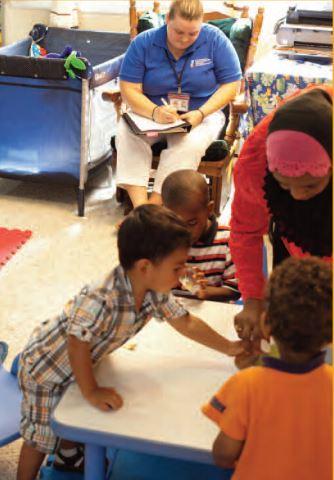
Figure \(\PageIndex{2}\): Documenting what you observe is an important part of the process. [39]
Tools to Use In Your Daily Routine
Running Record
To gather authentic evidence of everything you see and hear a child doing during a specific timeframe, you can use a running record. The primary goal of using a running record is to “obtain a detailed, objective account of behavior without inference, interpretations, or evaluations”. According to Bentzen, you will know you have gathered good evidence when you can close your eyes and you can “see” the images in your mind as they are described in your running record. [40]
Anecdotal Record
Whereas a running record can be used to gather general information more spontaneously, anecdotal records are brief, focused accounts of a specific event or activity. An anecdotal record is “an informal observation method often used by teachers as an aid to understanding the child’s personality or behavior.” [41] Anecdotal records, also referred to as “anecdotal notes,” are direct observations of a child that offer a window of opportunity to see into a child’s actions, interactions, and reactions to people and events. They are an excellent tool that provides you with a collection of narratives that can be used to showcase a child’s progress over time.
Developmental Checklists
To track a child’s growth development and development in all of the developmental domains including physical, cognitive, language, social, and emotional you will want to use a developmental checklist. With a checklist, you can easily see what a child can do, as well as note the areas of development that need further support. Teachers can create their own checklists based on certain skill sets, or to look at a child’s full range of development they can download a formal developmental milestone checklist from a reputable source (e.g., the CDC Developmental Milestones (https://www.cdc.gov/ncbddd/actearly/...checklists.pdf). Checklists can be used to track a large group of children or an individual child.
Frequency Counts
To gather information about a child’s interests, social interactions, play patterns, and temperamental traits you can use a frequency count chart. As you observe the children at play, a tally mark is made every time the noted behavior or action occurs within a set timeframe. Frequency counts are also used to track undesirable or challenging behaviors, as well as prosocial behaviors.
Work Samples
Creating a work sample requires more effort than hanging a child’s picture on the wall. A work sample provides tangible evidence of a child’s effort, progress, and achievement. Not only does a work sample highlight the final product , but it can also highlight the process. To collect authentic evidence, with every work sample you need to include the date and a brief caption that explains the child’s learning experience.
Documentation Boards
In addition to using the above tools and techniques to record observations, teachers can use documentation boards or panels to highlight the learning activities that are happening throughout the week, month, and year. Not only do families enjoy seeing their child’s work posted, but children can also be empowered by seeing all that they have accomplished. Documentation boards are another great way to validate progress over time. Documentation boards can be made with the children as a project or can be assembled by the teacher or parent volunteer. Typically, documentation boards are posted on the wall for all to see and they usually showcase the following information:
- Learning goal and objectives
- Children’s language development
- The process and complete project
- The milestones of development
- Photos with detailed captions
|
|
Pause to Reflect What might be pros and cons of each of the above tools for documenting your observations? Do you have any experience with any of them (as a teacher, family member, or child/student)? |
Interpret
After you have captured key evidence, you must now make sense of it all. In other words, you must try to figure out what it all means. As you begin to analyze and interpret your documentation, you will want to compare your current observations to previous observations. As you compare observations, you will want to look for play patterns and track social interactions. You will also want to look for changes in behavior and look for possible triggers (antecedents) when addressing challenging behaviors.
Lastly, you will want to note any new milestones that have developed since the last observation. To help you analyze and interpret your observation data, you will want to ask yourself some reflective questions. Here are some suggested questions:
- What have I learned about this child?
- What are their current interests – who do they play with and what activity centers or areas do they migrate to the most?
- Has this child developed any new skills or mastered any milestones?
- How did this child approach new activities or problem-solve when faced with a challenge?
- How long does the child usually stay focused on a task?
- Is this behavior “typical” for this child?
- *What can I plan to support and encourage this child to progress along at a developmentally appropriate pace?
Another vital step in interpreting your observations is to reflect and connect your observation data to developmental theories. ECE theories provide foundational principles that we use to guide our practices and plan developmentally appropriate curriculum.
Plan
Once you have interpreted your observation data (asked questions, looked for patterns, noted any changes in growth and development) and you have analyzed theory principles, it is time to plan curriculum. First, let’s define curriculum . According to Epstein (2007), c urriculum is “the knowledge and skills teachers are expected to teach and children are expected to learn, and the plans for experiences through which learning will take place (p. 5). I would like to define curriculum as “the activities, experiences, and interactions a child may have throughout their day.” Curriculum supports learning and play and it influences a whole child’s growth and development. As teachers set goals and make plans, they should consider that some curriculum will be planned, while some curriculum will emerge. As you plan your curriculum, you are encouraged to think about the following aspects of curriculum – the environment, materials, and interactions. For example,
- How is the environment set up – is it overstimulating, cluttered, or inviting and well organized?
- What is the mood and tone of the classroom – is it calm or chaotic? Do the children appear happy and engaged? Have you interacted with the children?
- Are there enough materials available – are children having to wait long periods of time for items and are there conflicts because of limited materials ?
- Do the materials reflect the children’s interests - are they engaging and accessible?
- What are the social interactions - who is playing with whom, are there social cliques, is anyone playing alone?
- Are the activities appropriate - do they support development in all areas of learning?
- Are there a variety of activities to encourage both individualized play and cooperative play? [42]
Implementation
Probably the more joyful part of our job is implementing curriculum and seeing the children engage in new activities. It is common to hear teachers say that the highlight of their day is “seeing the lightbulb go on” as children make valuable connections to what the teacher has planned and as the children master new skill sets. An important part of implementation is understanding differentiated instruction. According to Gordon and Browne (2016) when teachers can implement activities and materials to match the interests and skill level of each child, they are utilizing developmentally appropriate practices. For light bulbs to go off, intentional teachers must remember to “tailor what is taught to what a child is ready and willing to learn.”
Evaluate
Once you have planned your curriculum, gathered your materials, set up your environment, and implemented your activities, you will need to observe, document, and interpret the interactions so that you can evaluate and plan for the next step. Based on whether the children mastered the goals, expectations, and met the learning outcomes will determine your next step. For example, if the children can quickly and easily complete the task, you may have to consider adding more steps or extending the activity to challenge the children. If some children were unable to complete the task or appeared uninterested, you may consider how to better scaffold their learning either through peer interactions or by redefining the steps to complete the activity. As you evaluate your implemented activities here are some questions that you want to think about:
- How did the child approach the activity and how long did the child stay engaged?
- What problem-solving strategies did the child use?
- Did the child follow the intended directions or find alternative approaches?
- Who did the child interact with?
Based on your answers, you will decide on what is in the child’s best interest and how to proceed moving forward.
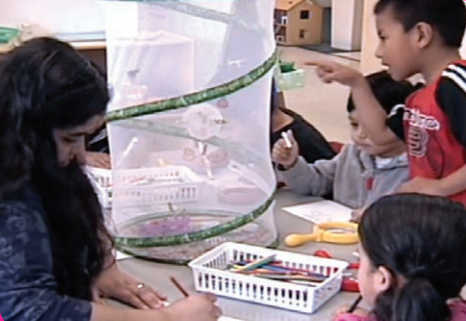
Figure \(\PageIndex{3}\): Evaluating the curriculum you implement helps you decide how to move forward. [43]
To Assess Children’s Development
Early childhood educators use assessments to showcase critical information about a child’s growth and development. As suggested by Gordon and Brown (2016) “Children are evaluated because teachers and parents want to know what the children are learning.” It is important to note that “assessment is not testing.” [44]
Assessment is, however, a critical part of a high-quality early childhood program and is used to :
- Provide a record of growth in all developmental areas: cognitive, physical/motor, language, social-emotional, and approaches to learning.
- Identify children who may need additional support and determine if there is a need for intervention or support services.
- Help educators plan individualized instruction for a child or for a group of children that are at the same stage of development.
- Identify the strengths and weaknesses within a program and information on how well the program meets the goals and needs of the children.
- Provide a common ground between educators and parents or families to use in collaborating on a strategy to support their child.
|
|
Pause to Reflect What is assessment and why is it important? As defined by Gordon & Browne (2016) assessment is “an evaluation or determination of the importance disposition, or state something or someone, such as evaluating a child’s skills, a classroom environment or a teacher’s effectiveness” [45] How could you explain what is assessment it and why assessment is important in your own words? |
The key to a good assessment is observation. [46] Whether you obtain your observation evidence through spontaneous or planned observations, it is suggested that you document your observations by utilizing various tools and techniques (e.g. running records, anecdotal notes, checklists, frequency counts, work samples, learning stories). As teachers watch children in natural settings, they can gather evidence that can then be used to track a child’s learning, growth, and development throughout the school year. To start the assessment process, here is a road map for you to follow:
- Step 1: Gather Baseline Data
- Step 2 : Monitor Each Child’s Progress
- Step 3 : Have a Systematic Plan in Place
Let’s look at each step more closely.
Step 1. Establish a Baseline
Before you can assess a child’s development, you must get to know your child. The first step is to gather “baseline” information. Through ongoing observation, you learn about each child’s strengths, interests, and skills. While observing you may also uncover a child’s unique learning styles, needs, or possible barriers that may limit them from optimal learning opportunities. For example, you may notice that when a child arrives in the morning, they tend to sit quietly at the table, and they don’t engage with other children or join in play activities. As you track the behavior, you begin to see a pattern that when a teacher sits with the child and they read a story together, the child warms up much faster than when left alone. Baseline information provides you with a starting point that can help you build a respectful relationship with each child in your class
Step 2. Monitor Progress
“The goal of observing children is to understand them better” (Gordon & Browne, 2016, p.119). Observations help guide our decisions, inform our practices, and help us to develop a plan of action that best fits each child’s individual needs. With every observation, we can begin to see how all the pieces fit together to make the whole child. To successfully monitor a child’s progress, we must look at the following:
- The child’s social interactions
- The child’s play preferences
- How the child handles their feelings and emotions
- The timeframe in which the child masters developmental milestones
- How the child processes information and is able to move onto to the next activity or level
With each observation, you gather more information and more evidence that can be used to assess the child’s development.
Step 3. A Systematic Plan
Once you have gathered an array of evidence, it is time to organize it. There are two different types of assessment systems:
- Program-developed child assessment tools are developed to align with a specific program’s philosophy and curriculum.
- Published child assessment tools have been researched and tested and are accepted as a credible source in assessing children’s development.
Forms of Assessment
Whichever system is in place at your program, you will need to be trained accordingly. In this section, we will highlight the use of portfolios and learning stories as well as discuss the Desired Results Developmental Profile (DRDP, 2015) as featured assessment systems that can be used to track a child’s development.
Portfolios
Portfolios help teachers organize all the work samples, anecdotal notes, checklists, and learning stories that they have been collected for each child throughout the school year. A portfolio is similar to a traditional photograph album, but it is much more than an album. A portfolio is “an intentional compilation of materials and resources collected over time” (Gordon and Browne, 2016, p. 112). A portfolio is not an assessment tool in and of itself, it is a collection written observation notes for each photo and work sample. The evidence clearly documents a child’s progression over time. Portfolios are important tools in helping to facilitate a partnership between teachers and parents. During conferences, teachers can showcase the portfolio as they share anecdotes of the child’s progress. Parents (and children) enjoy seeing all the achievements and chronological growth that has occurred during the school year.
Digital portfolios or e-Portfolios are trending now as technology has become more accessible. Not only do e-Portfolios enable teachers to document children's activities faster, but teachers can also now post information and communicate with families on a regular basis, rather than waiting until the end of the school year for a traditional family conference.
What are the strengths of portfolios?
- Information in a portfolio is organized in a chronological order
- Portfolios promote a shared approach to decision making that can include the parent and child and teacher.
- Portfolios do not have the same constraints and narrow focus as standardized tests.
- Portfolios help teachers to keep track of a child’s development over time
- Portfolios can help teachers develop richer relationships with the children in their classroom
What are the limitations of portfolios?
- To create and maintain a portfolio requires a large investment of time and energy
- Currently, there are no valid grading criteria to evaluate portfolios since outcomes can vary from one child to another
- Maintaining objectively can be challenging
Learning Stories
Learning Stories are written records that document what a teacher has observed a child doing. It becomes an actual learning story when the teacher adds his or her interpretation of the child's dispositions toward learning - such as grit, courage, curiosity, and perseverance. The story may be as short as one paragraph or as long as one page. Much like an anecdotal record, teachers observe and document brief moments as a child engages with peers or completes a task. With the learning story, however, the teacher connects learning goals and highlights developmental milestones that the child is mastering. With learning stories, teachers tend to focus on what the child can do rather than what they can't do. With almost all learning stories, teachers will take photographs (or video) to include with the written story.
What are the strengths of learning stories?
- By listening to, observing, and recording children's explorations, you send them a clear message that you value their ideas and thinking.
- As the teacher shares the Learning Story with the child, the child has the opportunity to reflect on his or her own development, thinking, and learning.
- The whole class can listen and participates in each other's stories and ideas.
- Learning stories provide parents with insight into how teachers plan for their children’s learning.
- Parents uncover that teachers are thoughtful and continuous learners.
- Learning Stories encourage families and children to talk about school experiences.
- Learning Stories showcase how powerful and capable children really are
What are the limitations of learning stories?
- The quality of the learning story depends on the teacher’s own subjectivity (ie: viewpoints, values, and feelings towards the child)
- Learning stories provide only a small snapshot of a child's learning.
- It takes time to write a learning story (teachers may only be able to write 1 or 2 stories per month) and critics argue that this may limit the amount of information a teacher will need to truly track a child's development
- Because learning stories are relatively new, there aren’t official guidelines on how often to write learning stories and what exactly they should be included
- Learning stories are written up after the event or interaction has actually happened - so teachers need to have a good and accurate memory!
Desired Results Developmental Profile (DRDP)
The Desired Results Developmental Profile (DRDP) is a standardized assessment tool that was developed by the California Department of Education (CDE), Child Development Division (CDD). Programs that are sponsored by the CDE, who serve children ages birth through 12 years of age (for example Lab schools, Head Start Programs, Early Start Programs, before and after school programs, SELPA programs, and other programs funded by Title V) are most likely to use the DRDP. The assessment results are intended to guide program improvement and to support teachers as develop curriculum to meet children’s individualized needs.
What are the strengths of the DRDP?
- The DRDP is aligned with California’s learning foundations and educational standards.
- The DRDP includes family support.
- The DRDP incorporates authentic observation, documentation, and reflection.
- The DRDP measures each child’s individual level of growth and development in all domains of development.
What are the limitations of the DRDP?
- Training teachers to be objective observers and aware of their biases can be challenging, especially with limited professional development opportunities.
- The tool may be considered rigid.
- Assessment, in general, is time-consuming
|
|
Pause to Reflect What are your thoughts about using portfolios, learning stories, and the DRDP? Which are you most drawn to? Why? |



